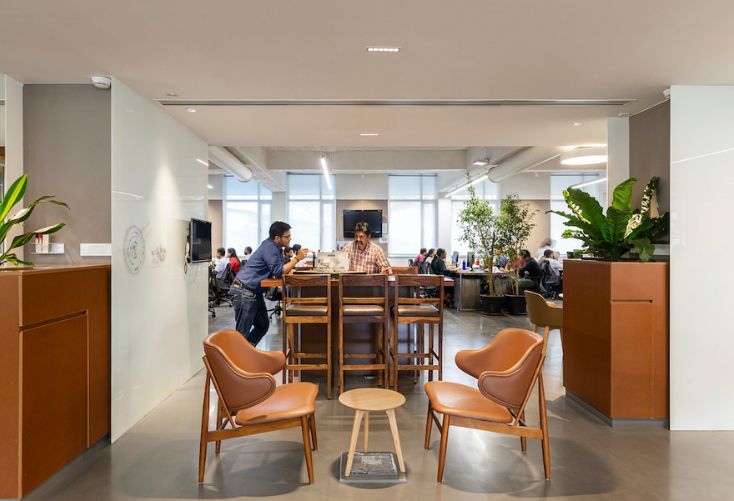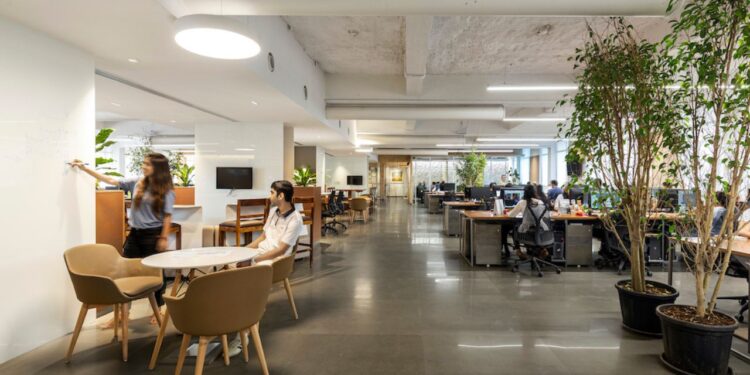- There is a growing demand to deliver technologically advanced workplaces in a humane and timeless manner. Smart offices are the need of the hour.
- Humanistic strategies include designing workplaces for the well-being of people, responding to the new requirements of COVID guidelines, ergonomics, universal accessibility and biophilia, through the use of technology.
- Technology helps in achieving the desired results efficiently with respect to indoor air quality, thermal comfort and lighting.
This article was written by Shaon Sikta Sengupta, and was originally published on Work Design Magazine.
The pandemic has led us to the biggest workplace experiment that the world has ever witnessed. This is quite opposite to the industrial revolution that got workers out of their homes to workplaces. Interestingly, while remote working is an accepted style today, two years into the pandemic, we see that office spaces are not being eliminated but instead are being optimized. There has been a lot written and discussed about the future of work, yet some questions remain unanswered for the post-pandemic world. What will the new-age office space look like? Are we taking stock of the new spatial requirements? What goes into the design of a post-pandemic workplace? How do we optimize it? Is technology the aid?
The pandemic has inherently shown us that new-age workplaces are deploying data-driven design for a data-driven future. In other words, there is a growing demand to deliver technologically advanced workplaces in a humane and timeless manner. Smart offices are the need of the hour – spaces that embrace sustainability and are driven majorly by the combination of humanistic and technological strategies. Through these strategies, it is important to consider the altered attitudes towards presenteeism and usage levels in office, and the corresponding shift in spatial and experiential requirements as well. Humanistic strategies include designing workplaces for the well-being of people, responding to the new requirements of COVID guidelines, ergonomics, universal accessibility and biophilia, through the use of technology.

While designing for well-being, other than the default factors such as office layout, material and furnishing, and acoustics, technology helps in achieving the desired results efficiently with respect to indoor air quality, thermal comfort and lighting.
Indoor Air Quality
The indoor air quality, pre or post the pandemic in places like New Delhi has created an increasing demand by larger Indian and Multinational companies for regulated and controlled methods. Technology mainly aids in achieving optimization in this regard as opposed to the usual uninformed processes. Air purifiers with Ultraviolet Germicidal Irradiation (UVGI) systems can be proposed on various locations inside the offices to purify the air. Such strategic spatial layouts of air purifiers also enable monitoring and transferring of real-time data about the indoor air quality. The air purifier filtration system combines an activated Carbon filter and HEPA filter to remove microscopic pollen and allergens, bacteria and mold, chemicals, odours and gases.
Thermal Comfort
Thermal comfort and indoor air quality go hand-in-hand while designing for well-being in workplaces. A strategic implementation of Under Floor Air Distribution (UFAD) system with UVGI is necessary to improve indoor air quality and thermal comfort, so that no air is re-circulated inside the space. A UFAD system uses underfloor air diffusers to supply conditioned air directly into the occupied zone. Floor mounted air diffusers and ceiling mounted return air plenum help prevent the transmittal of harmful bacteria from air-conditioning, a key problem in enclosed office spaces. Unless there is technology-driven user interface put into the design, it is difficult to have ever-fluctuating optimal requirement that the user can go through. Optimal designing is key – while we want to provide comfort to the users, we may not want to go overboard in terms of finances, energy consumption, etc.
Lighting
Circadian rhythm and the 24×7 office relate to the emotional experience achieved through lighting design. This is because modern workplaces are open throughout and function around the clock. The banes of using a 24×7 office space are that a user enters the office in the morning when his body, mind and senses are tuned to an external environment. By the end of the day, when one steps out of the office, just like thermal shock, there is also environmental shock. Specialized smart office lighting solutions that automatically adjust indoor lighting based on circadian rhythms help in achieving peak performance around the clock.

Accessible Design
Ergonomic and Universal Accessible design is one of the most important smart office details – interventions in the elements in an office space such as tables, chairs, workstations, task lights, monitor supports, keyboard trays that address the sensibilities and individual requirements of various kinds of users through the aid of technology.
Biophilic Design
Biophilic design is not only about plants. In workplace design, it is highly important to bring the outdoors to the indoors in terms of various aspects ranging from environmental features, natural shapes and forms, natural patterns and processes, light and space, place-based relationships, evolved human-nature relationships. Acoustic control and environmental music are proven to achieve higher levels of well-being, higher productivity, and creativity. For example, better acoustic control can be delivered through absorptive surfaces such as moss walls, while the sounds of nature can be deployed strategically in ‘green zones’ along with scents as a unique employee hospitality experience.



 Dr. Gleb Tsipursky – The Office Whisperer
Dr. Gleb Tsipursky – The Office Whisperer Nirit Cohen – WorkFutures
Nirit Cohen – WorkFutures Angela Howard – Culture Expert
Angela Howard – Culture Expert Drew Jones – Design & Innovation
Drew Jones – Design & Innovation Jonathan Price – CRE & Flex Expert
Jonathan Price – CRE & Flex Expert












